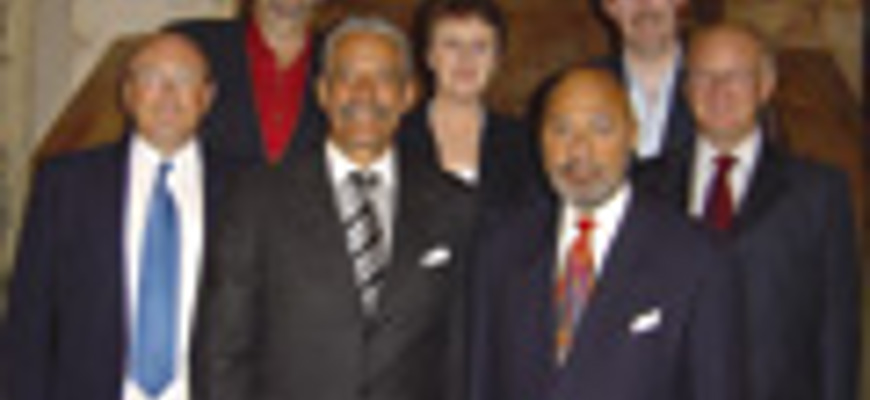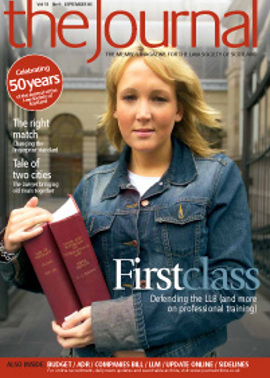A shot in the arm

“It was without doubt the best conference I’ve ever attended.” Douglas Mill is on a high after returning from the annual meeting of his counterparts from across the globe.
The average practising lawyer will not often come across IILACE (pronounced “eye-lace”), the International Institute of Law Association Chief Executives. But for Mill, confirmed at the conference as the Institute’s President for the next two years, IILACE performs an invaluable function in bringing a wider perspective to the issues that cross his desk on a daily basis.
“The organisation does two key things. It deals with law association issues, the interface between elected members and paid staff, and also geopolitical legal topics like the rule of law and all the issues coming out of the Clementi report.”
IILACE, which largely operates at the working level via email and telephone conference calls, actually came into being at the Law Society of Scotland’s 50th anniversary conference in 1999, though Mill insists that the credit belongs to an Australian, Barry Fitzgerald. He it was who had felt the need for an international networking forum, and pulled together a couple of dozen likeminded office holders from the worldwide gathering in Edinburgh for the conference, to set it going.
On its own feet
Seven years later, with a membership of about 45 chief executives or equivalent – every continent except South America is represented – for the first time IILACE tried a “stand alone” conference, in Mill’s words, rather than one piggybacking on another event. “We were worried that people might not come, but we had a record attendance. It was doubly encouraging because it was the first time we’ve been in a location where we did not have a host law society organising it for us, so it really was an acid test to prove whether we’d come of age and I think we have.”
The programme for the New York meeting reveals some weighty business. The first two sessions featured past presidents of the American Bar Association – Dennis Archer on the role of lawyers in contemporary society, and Robert Grey on building relations with government (this on the back of an ABA campaign over the Guantanamo Bay detainees). Further themes were reforms to the profession underway in different jurisdictions, expectations of workload and remuneration for elected law society presidents, multi-jurisdictional practice and ethics rules, the role of volunteer help in law associations’ work, challenges and innovation for associations, and innovation in professional indemnity insurance.
Underlying both the rationale for IILACE and some of the programme topics is the increasingly significant role played by people like Douglas Mill in keeping the longer term strategy and agenda of a law society on track. “What’s been felt in virtually every jurisdiction is that due to the increasing pace of life for all our office bearers these days, particularly their relational and ceremonial duties, progressing agenda issues can easily fall onto the shoulders of the CEO and a place for longer term thinking is required for these things, so it’s to assist with that”, he explains.
Role models
“Another major byproduct, though it’s not in the objects clause or anything, is paranoia reduction. When you go to these conferences you realise that everybody has the same problems as you, although perhaps in varying degrees. The Australians and Canadians tend to be further ahead than us; they’re the two jurisdictions I learn most from in terms of the shape of the future.”
And at a time when his morale can be severely tested by attitudes back home, within the profession as well as in government, Mill takes a great personal lift from outsiders’ regard for Scotland. “From my point of view it was quite simply a real privilege to chair such a major conference. As I’ve said before I think it’s a tribute to the continuing esteem in which Scots law and the Scottish legal system is held, though that’s something we never take for granted, bearing in mind the current developments.”
Why the high regard? “Ironically we’re looked on as one of the really solid regulators, as a robust and mature jurisdiction. I think a lot of other jurisdictions find it hard to reconcile what’s happening to the Law Society of Scotland in terms of regulation with this regulatory record and the fact that a lot of them have actually modelled themselves on us over the years – for example the South African Fidelity Fund.”
“If we in Scotland felt as good about our legal profession and legal system as people from abroad do, we’d be in a much better state. It’s the usual thing about Scots people not being good salesmen and undervaluing what they’ve got.”
As Douglas Mill returns to grapple with the Legal Profession Bill – which he reckons is occupying about 70% of his working hours at the moment – he at least has the reassurance that taking the global picture, the Society is not alone.
In this issue
- Sincere thanks are due
- From the grass roots
- Training solicitors and teaching law
- Survival of the fittest?
- A new print job
- Plenty more besides
- That's settled, then
- East meets west
- A shot in the arm
- Tapping into CPD Online
- Master trainee
- Glitch hunt, not witch hunt
- A caveat on witnesses
- Victories for tenants?
- On your marks...
- Big bill for business
- Ripple effect
- How fair is fair?
- Scottish Solicitors' Discipline Tribunal
- Website reviews
- Book reviews
- Spinning plates
- Sending the right signals






